STO-CMRE (Science and Technology Organization – Centre for Maritime Research and Experimentation)
The STO-CMRE (Science and Technology Organization – Centre for Maritime Research and Experimentation) is located in La Spezia, Italy. Formerly NATO Undersea Research Centre (NURC), the Centre focuses on research, innovation and technology in areas such as defence of maritime forces and installations against terrorism and piracy, secure networks, development of the common operational picture, the maritime component of expeditionary operations, mine countermeasures systems, non-lethal protection for ports and harbours, anti-submarine warfare, modeling and simulation, and marine mammal risk mitigation. CMRE operates two ships, NATO Research Vessel Alliance, a 93-meter 3,180-ton open-ocean research vessel, and Coastal Research Vessel Leonardo, a smaller ship designed for coastal operations. In addition to its laboratories the Centre is equipped with a fleet of autonomous underwater and surface vehicles and a world-class inventory of seagoing sensors.
NATO Exercise Tests Unmanned Mine-hunting Tactics
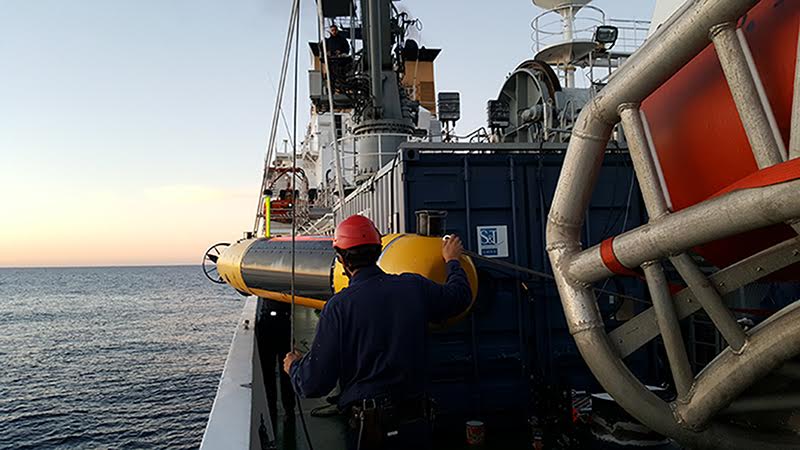
MUSCLE Autonomous Underwater Vehicle Deployment - Photo courtesy of CMRE
20 September 2016 - From 15 to 28 September 2016, the NATO Research Vessel Alliance, operated by the Italian Navy for the NATO Centre for Maritime Research and Experimentation (CMRE) based in La Spezia (Italy), is taking part for the first time in exercise Olives Noires 2016 in the Mediterranean sea, off the French coast. Olives Noires 2016 (ON16) is a live exercise involving NATO, French, Italian, Spanish, Greek and Slovenian naval units. The aim of the exercise is to enhance operational readiness levels and multinational cooperation training between NATO and French maritime forces in tactics and procedures in the littoral environment.
The primary purpose of the CMRE experiment in Olives Noires 2016 is to test solutions and advance methods for using robotics in mine countermeasures (MCM). Conventionally, the different phases of MCM (search, detect, classify, reacquire and identify) are performed in sequence making this a time-consuming effort. For the first time, CMRE is conducting specific experiments in which multiple robots tasked with different goals work in the same water space simultaneously to demonstrate an accelerated MCM timeline. In practice, experimental autonomous underwater vehicles (AUVs), including the MUSCLE prototype developed by CMRE, are being deployed together to detect, classify and identify simulated naval mines on the seafloor, using their automatic behaviour capabilities. As part of this work, new methods for allowing the vehicles to localise themselves better and new types of sensors are also tested.
In the future, these robots will not only be intelligent and able to take autonomous decisions, but also capable to coordinate actions in groups by simultaneously carrying out different multiple complex tasks and thus resulting in quicker surveying solutions. The ongoing initial experiments to support the research and operational analysis include close collaboration with universities from Girona (Spain) and Heriot-Watt (UK). Additionally, experiments are being conducted in conjunction with the conventional MCM vessels from multiple nations participating in ON16, to compare the performance of robots with legacy systems and assess practices for joint operations.
The outcome of this research will ultimately result in increasing the capabilities of the NATO Alliance in the MCM field. CMRE also aims to demonstrate that having more localised and specialised autonomous equipment the overall mission performance of a system-of-systems will increase.
The exercise was presented to the press on 20 September 2016 on board BCR Somme off the coast of Toulon. CMRE Scientist in Charge for ON16 experiments, MCM Programme Officer and NRV Alliance First Officer participated.
NATO Naval Exercise Features Autonomous Vehicles
18 July 2016 - Several different Autonomous Surface Vessels (ASVs), Autonomous Underwater Vehicles (AUVs) and Unmanned Aerial Vehicles (UAVs), equipped with different sensors and acoustic payloads, are operating together in the seventh annual edition of REP16-Atlantic exercise, a joint exercise of the Portuguese Navy, the NATO Centre for Maritime Research and Experimentation (CMRE), and the University of Porto.
REP16-Atlantic stands for Recognized Environmental Picture (REP) Atlantic 2016 and it is being conducted from 5 to 31 July in the Atlantic Ocean, off the coast of Portugal, south of Sesimbra and Setubal. It also involves participants from the Belgian Navy, Oceanscan (Portugal), as well as observers from Naval Undersea Warfare Center (USA), NASA (USA), and European Project H2020 JPI Oceans.
For the third time in a row, the nexus of autonomous solutions is at sea to demonstrate robotic capabilities in mine countermeasures, expeditionary hydrography, search and rescue, maritime law enforcement operational scenarios, and Rapid Environmental Assessment. This will also include the demonstration of a solution regarding the operational use of SeaCon Class AUVs in combination with the Portuguese “Tridente” Class Submarines.
REP16-Atlantic aims at assessing how significantly multi-domain cooperative robotics could improve current capabilities of Navies at sea. To this end, robots are being deployed from the Portuguese navy ships NRP Escorpião, NRP Pégaso, NRP Andrómeda, NRP D. Carlos I, submarine NRP Arpão, in addition to the NATO Research Vessel Alliance.
CMRE scientists on board the NATO ship, in particular, are testing collaborative autonomous behaviours of underwater vehicles for ASW applications, while also testing the performance of network-based solutions for vehicle localization and navigation. For underwater acoustic communications, networking and equipment capabilities are being tested, including Wave Gliders used as autonomous gateways. The exercise includes an assessment of the capabilities of JANUS, an underwater digital communication protocol, developed at CMRE, which is in the process of becoming a NATO standard and is currently being promoted in the maritime industry.
Through REP16-Atlantic, all the partners will enable collaborative research to increase interoperability and underwater communications capabilities, automation and cooperation of unmanned underwater, surface and aerial vehicles.
REP16-Atlantic also marks the first international research campaign of the NATO Research Vessel Alliance after the new flag agreement with the Italian Navy.
The REP16-Atlantic features and objectives will be presented on 18 July in Lisbon (Portugal), in the presence of Rear Admiral Matthew A. Zirkle (U.S. Navy), Deputy Chief of Staff Submarines – COMSUBNATO, Ana Paula Vitorino, Minister of the Sea of Portugal, Marcos Perestrello, Secretary of State for Defence, General Artur Neves Pina Monteiro, Chief of Defence of Portugal.

NATO CMRE Makes Strides in Synthetic Aperture Sonar Data Storage
1 March 2016 - The Centre for Maritime Research and Experimentation (CMRE), an executive body of NATO’s Science and Technology Organization (STO), has produced a major breakthrough in swappable Autonomous Underwater Vehicle data storage.
Collaborative Autonomous Mine Countermeasures (CA-MCM) is one of the main projects at CMRE, aiming at increasing the capabilities of autonomous underwater vehicles (AUVs) by using Synthetic Aperture Sonar (SAS) to quickly and reliably detect, classify and localise mines. This implies the use of high performance, efficient processing systems installed in underwater robots working in real-time.
Challenge
The CMRE CA-MCM project focuses on increasing the efficiency and effectiveness of the full range of mine search missions. Advancing the use of AUVs for mine countermeasures has been achieved in a three-pronged approach:
1. The research and development of data processing algorithms for through-the-sensor underwater perception and autonomous behaviours for optimal data acquisition,
2. The development and implementation of the algorithms onboard the vehicle in real time,
3. The maintenance and upgrade of the vehicle, its onboard processing capabilities and its sensors.
The research axis has gone from basic way-point following to the development of a machine decision making capability. Incremental steps taken along the way include the development and implementation of:
• operator interrupt and redirect,
• real time onboard SAS processing at 3cm along track resolution up to 150m range,
• world-leading onboard target detection and classification,
• novel sensing and adapting to sand ripples algorithms,
• sensing and adapting to adverse currents algorithms,
• sensing and analysing environmental information,
• extracting from different types of data environmental attributes such as complexity in terms of mine-hunting of an area,
• assessing the quality of the data,
• adapting track spacing to ensure optimal area coverage,
• autonomous re-acquisition of multiple views on detected targets,
• task arbitration and machine decision making for behavioral deconfliction.
The next generation of Autonomous Underwater Vehicles (AUVs) currently developed at CMRE is equipped with wide suite of sensors with onboard processing capabilities as well as a very high level of autonomy and adaptation to the environment in order to achieve high level mission tasks without human intervention. High computational power, large data acquisition and storage are needed to enable these features. Furthermore, the continuous development on these systems requires even larger storage capacity and very high reconfigurability.

© CMRE, The MUSCLE vehicle is recovered after an underwater mission
One of the best example of these vehicles equipped with the PicoITX boards is the MUSCLE, CMRE's major MCM AUV. With a high-resolution, high-frequency synthetic aperture sonar (SAS) installed, MUSCLE provides superb image quality of objects on the seafloor, and it has a high level of autonomy, thanks to its real-time processing software running on a dedicated high-end GPU-based system and advanced decision making capabilities. Despite its relatively low TRL (Technology Readiness Level), the MUSCLE unmanned vehicle is regularly tested and successfully utilized in operational Mine Countermeasure (MCM) scenarios in which a very quick turnaround time from mission execution to post mission analysis and very short mission to mission downtimes are key factors.
Solution
CMRE began developing concepts for allowing a quick data transfer on autonomous vehicles in 2014. The challenges developing an underwater field swappable storage unit are in the use of unconventional underwater connectors (typically not suited for standard data buses) and the miniaturization imposed by the portability of the system despite its ability to sustain high pressures.
The SECO Pico ITX boards with two Gigabit Ethernet ports and 2 SATA3 channels combined with their small form factor seemed a possible solution for such applications. The full integration of one of these boards into a small water-tight 300m rated case developed and built at CMRE was successfully accomplished in 2015. The system has then passed multiple bench tests and it is now approaching the field testing stage. The high computational power and the possibility of installing up to 8GB of RAM will allow for some data processing contribution to the over all reduction of the post-mission-analysis time.
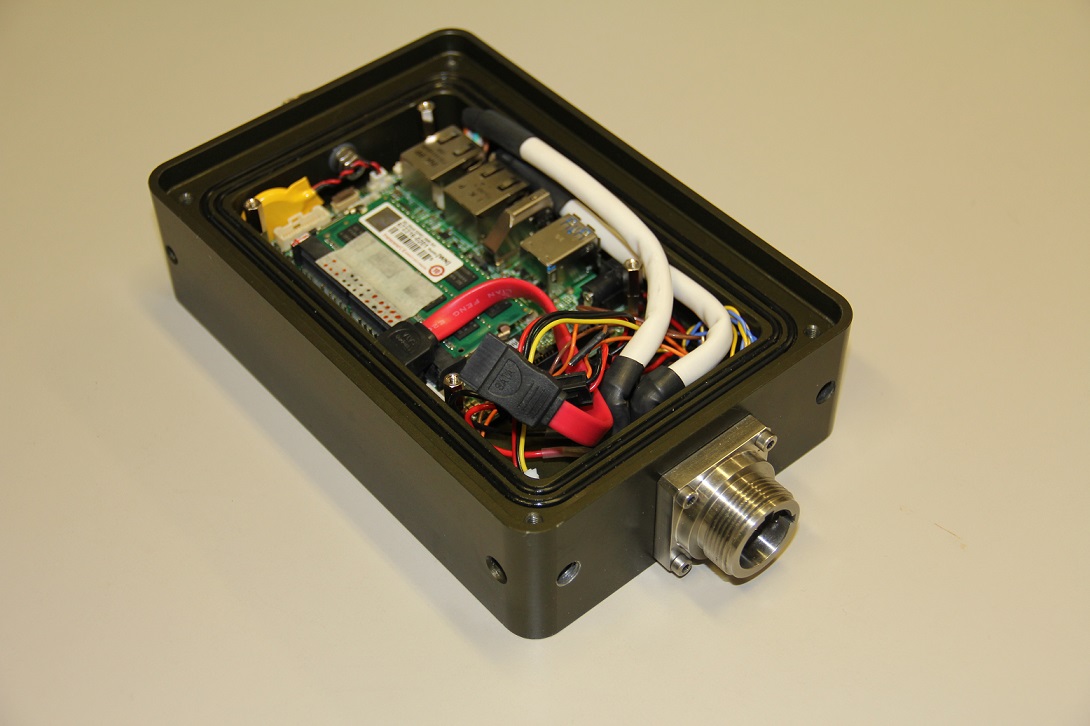
© CMRE, SECO pITX board installed into CMRE custom underwater case (300m depth rated)
Impact
The newly built underwater field-swappable storage unit is expected to significantly reduce the mission-to-mission downtime due to the data transfer from hours to minutes. This will make multiple missions in the same day possible and it will bring the operational readiness of the CMRE underwater robots, in particular the MUSCLE AUV, one step further. The quick storage unit swap will also allow the operator to have access to the results produced by the advanced internal processing unit of the MUSCLE AUV during the mission execution.
Thanks to the processing power of the SECO Pico ITX boards, the new system has been designed by CMRE to run completely autonomously from the other vehicle’s subsystem and it is capable of retrieving and storing the mission data fully unsupervised. Its use as a secondary storage unit allows for higher data integrity.
The SECO Pico ITX boards have also been successfully tested with NATO approved storage units used in applications with strong requirements in terms of Information Assurance. The availability on the market of different CPUs/SOCs (Systems on Chip), from ARM to x86, gives a wide range of options and power consumption vs processing power ratios. As a result, CMRE already envisages using this storage unit on multiple vehicles part of its fleet.
NATO Maritime Research Arm Supports Mine-hunting Exercises
19 October 2015 - NATO's Centre for Maritime Research and Experimentation (CMRE) and its scientists are contributing to Trident Juncture training objectives, while conducting scientific experiments in the vicinity of the exercise area. In particular CMRE will deploy the NATO Research Vessel Alliance from 14 to 28 October 2015 along the Spanish coastline in order to advance the use of modern mine-hunting systems such as underwater robots. The vessel will also serve as a boarding platform for boarding teams and acting as vessel of interest, in support of TJ15 Maritime Security training objectives.
Search, classification and mapping missions will be tested with the MUSCLE underwater vehicle, the CMRE mine hunting mature prototype equipped with a high resolution, high frequency synthetic aperture sonar (SAS). MUSCLE is well-suited for operations in coastal waters, it can produce superb image quality of objects on the seafloor. It has excellent navigation capabilities and the ability to cover a large area during designed autonomous mission.
As part of the Trident Juncture Mine CounterMeasure Experiment, NATO EXTAC 873 (new experimental tactics for underwater robots) will be exercised, surveys over scientifically challenging seabed will be conducted to test the development of automatic target recognition (ATR) in difficult environments, multi-view ATR and autonomy algorithms. New upgrades for on-board processing capabilities will be also experimented. Finally, enhanced task arbitration will be integrated into the vehicle enabling the vehicle to autonomously decide, based on environmental knowledge, whether to adapt to ripples or currents as a priority.
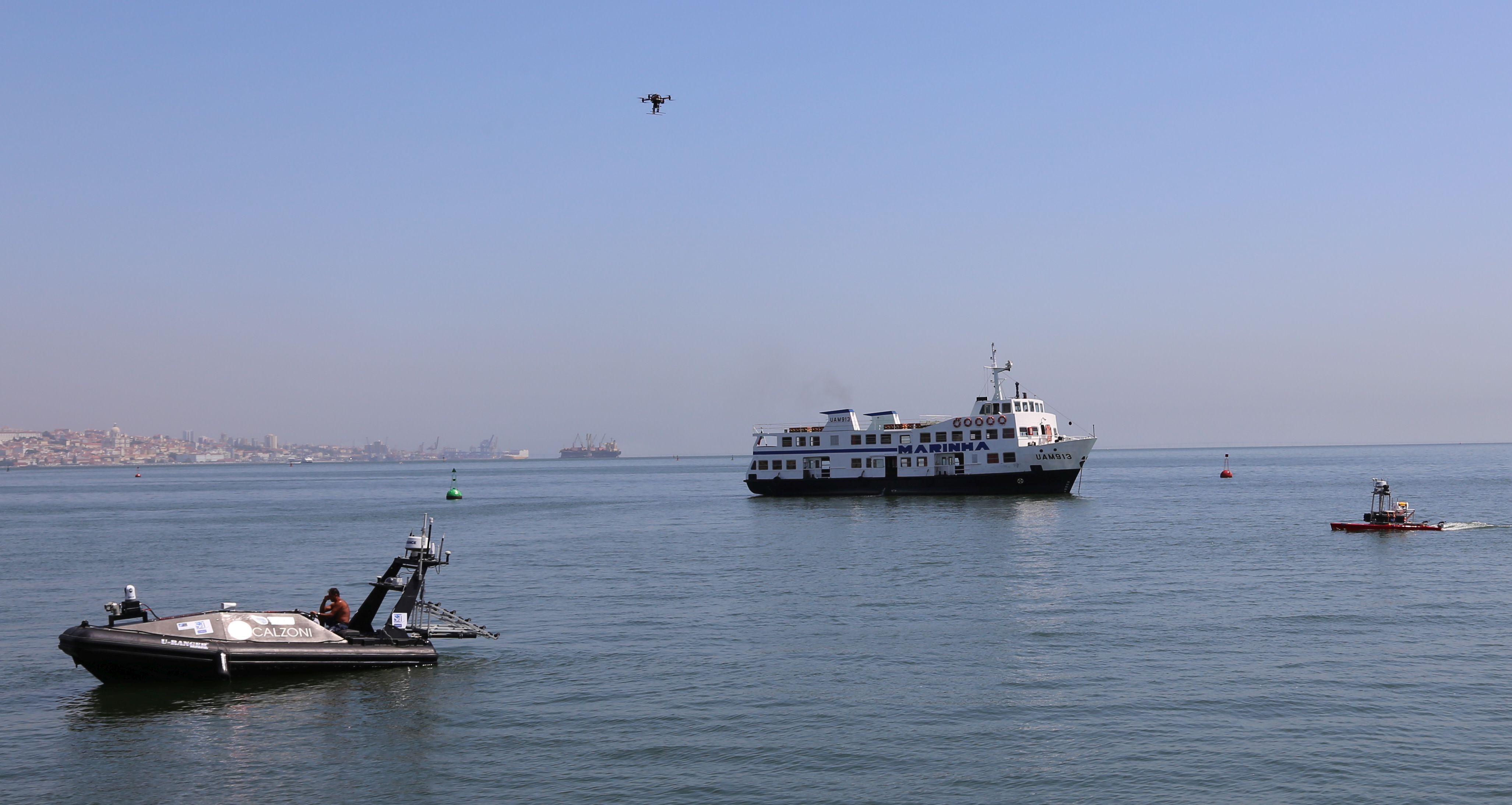
CMRE's Unmanned Search & Rescue System to Debut in 2016
15 July 2015 - NATO's Centre for Maritime Research and Experimentation (CMRE) played a crucial role in developing the maritime component of the ICARUS European search and rescue project, including enhanced autonomy and integration between Unmanned Surface Vehicles and Unmanned Aerial Vehicles.
On 9-10 July 2015, at the Portuguese Navy Base of Alfeite (Almada) in Lisbon, 24 Project Partners from 9 countries demonstrated the ICARUS (Integrated Components for Assisted Rescue and Unmanned Search Operations) system, as final step of the ICARUS European project funded by the European Commission under the Seventh Framework Programme for Research and Innovation (FP7). Begun in 2012, ICARUS has been devoted to develop advanced robotic platforms which can support crisis intervention teams in detecting, locating and rescuing humans in danger, in maritime and land disaster scenarios. Unmanned Search and Rescue (SAR) devices offer valuable tools for saving human lives and for speeding up the SAR process. This is particularly crucial for maritime incidents, in which survival times are short and during which even SAR teams take considerable risks.
During the ICARUS final event in Lisbon, the Project Partners coming from Portugal (CINAV, INESC, ESRI), Spain (EURECAT and INTEGRASYS), Switzerland (ETHZ), Italy (CMRE, Calzoni), Poland (IMM) and Belgium (Space Application Services) demonstrated the effectiveness of the system in case of maritime accident. “Let’s say that a passenger ship strands or drowns in high sea, but the atmospherical and maritime conditions do not allow the search and rescue teams to perform the victims’ rescue operations in safety”, says Aníbal Matos, researcher from INESC TEC (INESC Technology and Science) and lecturer at the Faculty of Engineering of the University of Porto (FEUP), one of the responsible people for ICARUS Sea Trials in Lisbon 2015. “One solution would be to use autonomous robots that can help these teams in catastrophic situations”.
The demonstration included Unmanned Surface Vehicles (USVs) and Unmanned Aerial Vehicles (UAVs), linked together in a shared robotic network that enhances interoperability and full collaboration. CMRE intelligent autonomy tools have been fully integrated into an existing robotic asset (USV) developed by an Italian company, L3 Calzoni. “Thanks to CMRE cutting-edge innovative technologies, the system, assisted by an unmanned salvage boat developed by INESC-TEC, is now capable of full autonomous SAR operations at sea with minimal human supervision. All the robots are integrated by means of standard protocols into the ICARUS robotic network” explains Stefano Fioravanti, Scientist in Charge for ICARUS at CMRE.
The system will be ready for use from 2016 when the ICARUS project officially ends. The Project’s Consortium includes end-users, such as the Portuguese Navy and the Belgian First Aid and Support Team (B-FAST), which already showed interest in further exploitation of the technology, as complementary support tool for SAR teams.
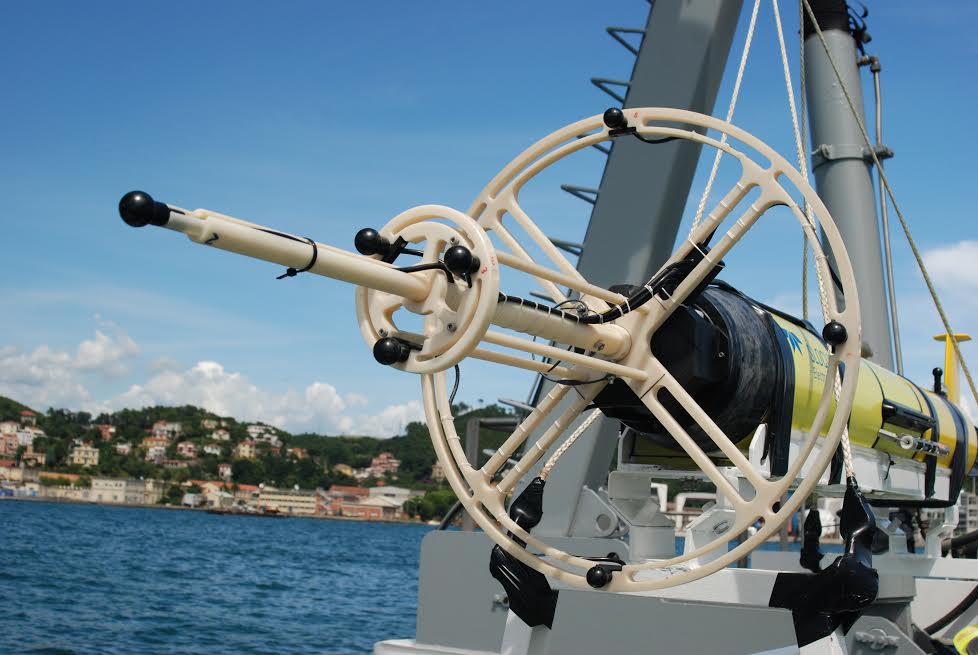
CMRE Demonstrates Systems for Persistent, Autonomous and Real-time Maritime Surveillance
10 July 2015 - NATO's Centre for Maritime Research and Experimentation (CMRE) recently completed demonstrations of unmanned passive monitoring at sea as part of the PERSEUS FP7 European project.
Conventional surveillance technologies cannot easily help to detect fast boats, which generally have small radar signatures and do not carry automatic identification systems (AIS). For this reason, the NATO STO CMRE (Centre for Maritime Research and Experimentation) has addressed this problem along with other project
partners, as part of the European project PERSEUS.
The PERSEUS project (Protection of European BoRders and Seas through the IntElligent Use of Surveillance), coordinated by Spanish technological company Indra, is one of the most significant initiatives within the 7th Framework Programme of the European Commission, and has constituted the flagship of R&D in the maritime security segment.
In the Project’s term, ended in June 2015, CMRE scientists and engineers worked to design, develop and demonstrate at sea concepts of continuous, real-time passive underwater acoustic systems for maritime surveillance. The objectives have been successfully met by using innovative solutions integrated on board unmanned mobile platforms, i.e. both on an underwater glider (an autonomous underwater vehicle which uses shifts in mass to steer and changes in buoyancy to dive and surface) and a Wave Glider (an autonomous vehicle with a surface float and a submerged glider, generating forward movement by exploiting sea wave energy).
The embedded cutting-edge passive sonar surveillance system proved to be particularly effective due to its real-time continuous monitoring capability and the availability of several functionalities ranging from detection and localization to vessel classification. Furthermore, the platform/system combination has proven to be persistent and covert with wide area coverage and minimum environmental impact. Real-time detections and localizations have been made both on board the underwater glider and the Wave Glider, and the detection/tracking results have been disseminated to both CMRE and national control centers for display and further analysis.
Target classification algorithms have also been applied successfully in near real-time during at-sea demonstrations. Adaptation of the Wave Glider for shallow coastal waters was tested by adding low-cost add-ons for above water sensing, in the form of inexpensive daylight and thermal cameras, and radar detection devices. This technology may help enabling the detection of anomalous behaviours of marine traffic by fusing the above and the underwater picture.
CMRE has been the first organization to demonstrate a complete system for underwater acoustic surveillance with highly persistent mobile robots. In the future, these systems could be used within a network to continuously monitor maritime areas of interest.
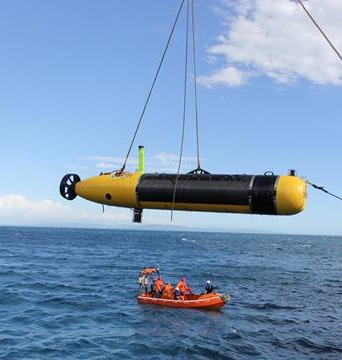
Muscle AUV - Photo courtesy of CMRE
NATO Navies Complete Multi-AUV Minehunting Exercise
31 May 2015 - From 20 to 29 May 2015 CMRE (Centre for Maritime Research and Experimentation) scientists, along with colleagues from the Royal Netherlands Navy Defence Diving Group, Naval Mine Warfare Centre of Excellence (EGUERMIN) and UK Royal Navy Maritime Autonomous Systems Trials Team (MASTT), experimented with different unmanned underwater vehicles in a joint scientific mine countermeasures (MCM) sea trial.
NSMEX’15 (North Sea MCM Experiment 2015) sea trials took place in the North Sea off the coast of Ostend, Belgium. The exercise included the first time the NATO Research Vessel (NRV) Alliance, a 93-meter 3,180-ton open-ocean ship, operated in Belgian waters.
The experiment aimed at exercising state-of-the-art high-resolution underwater acoustic imaging systems and adaptive vehicle behaviours using different Autonomous Underwater Vehicles (AUVs) in order to assess the performance of different sonar systems and enhance interoperability and collaboration in the field. During NSMEX‘15 multiple simultaneous underwater robot surveys were successfully conducted in the very challenging North Sea environment characterized by strong currents and complex seafloors. The positive results from this trial will allow NATO and partner nations to gain experience in how these types of systems can be used in joint mine countermeasure missions, and will also permit CMRE to further characterize the performance of its systems in different environments.
Initial results from this scientific campaign, including data from CMRE's MUSCLE AUV, will be presented at EGUERMIN on 1 June 2015.
NATO Research Center Completes Unmanned Search & Rescue Trials
24 October 2014 - The NATO Centre for Maritime Research and Experimentation (CMRE), part of the NATO Science and Technology Organization, recently hosted maritime sea trials delivered in the context of the ICARUS (Integrated Components for Assisted Rescue and Unmanned Search operations) project, which is funded by the European Commission under the Seventh Framework Programme for Research and Innovation (FP7). The trials were held between 13 October and 24 October 2014.
ICARUS has been developing advanced robotic platforms which can support crisis intervention teams in detecting, locating and rescuing humans in danger, in maritime and land disaster scenarios, since 2012.
Unmanned Search and Rescue (SAR) devices offer a valuable tool for saving human lives and for speeding up the SAR process. This is particularly crucial for maritime incidents, in which survival times are short and during which even SAR teams take considerable risks. For such events, Unmanned Surface Vehicles(USVs), capable of transporting SAR equipment and deploying first aid devices, can greatly improve the efficiency of operations.
The integration of robotic platforms, including Unmanned Surface Vehicles (USVs) and Unmanned Aerial System (UAS), was successfully tested and demonstratedat CMRE during the ICARUS 2014 sea trials.
Existing technologies have been improved to strengthen resilience, and new developments include robotic vehicles that can deploy autonomous lifesaving capsules,using mission planning software, new sensors and new data acquisition capabilities to detect and track survivors. CMRE has world-leading expertise in maritimerobotics and target recognition. In the framework of the ICARUS project, the Centre is collaborating with INESC (Laboratory of Microgrids and Electric Vehicles, Portugal), to enhance the autonomy of the robotic surface vehicles and is also involved in the integration of the main USV into the ICARUS Command, Control and Interface (C2I) station for collaborative operations with aerial robots.
The ICARUS project is managed by a consortium of 24 partners from 10 countries which includes stakeholders from industry, Small and Medium-sized Enterprises,research institutes and end-users, such as the Portuguese Navy and the Belgian First Aid and Support Team (B-FAST). One of the main objectives of the project isto bridge the gap between robotic laboratories and the application of novel robotic devices to real-life situations in the field, paving the way for cutting-edgetechnologies to be used in Search and Rescue operations. The technologies developing during the ICARUS project will be tested in 2015 during two majordemonstration events: a simulated earthquake exercise in Belgium and a maritime accident exercise in Portugal.
NATO Researchers Uncover Seabed Secrets with Underwater Robots
2 October 2014 - The NATO Research Vessel Alliance is conducting the Multinational AutoNomy Experiment (MANEX ‘14) along the Ligurian coast, in order to demonstrate the advantages of mapping the seabed using autonomous vehicles.
From 22 September to 13 October 2014, multiple autonomous underwater vehicles (AUVs) equipped with modern sensors relevant to NATO minehunting missions are being employed at sea during the Multinational AutoNomy Experiment (MANEX ‘14) along the Italian coast, between Framura and Bonassola, in the Ligurian sea. Onboard the NATO Research Vessel Alliance, operated by the NATO Centre for Maritime Research and Experimentation (CMRE), part of the NATO Science and Technology Organization, scientists and engineers from eight institutions and ten Nations are exercising state-of-the-art high resolution underwater acoustic imaging systems and autonomous vehicle behaviours. The purpose of the trial is to collect data that will allow NATO researchers to advance the state-of-the-art in the area of seabed mapping using autonomous vehicles, mainly for mine countermeasures applications. The use of robots removes the need for Navy personnel to operate in a potentially dangerous area like a minefield, and ensures their safety. Improved capabilities in seabed mapping can also lead to positive advancements in other fields such as support for environmental and archeological surveys.
CMRE has a world-leading expertise in autonomous mine countermeasures and seabed mapping. For many years, in fact, the Centre has been working to transform the way mine countermeasures are conducted, from a post-Cold War approach, that focuses on post-operations clearance using surface ships, to a quickly deployable, autonomous system-of-systems that is scalable, cost effective, and minimizes risk to personnel. This includes developing techniques for handling the large data rates associated with modern high-resolution sonar, and developing AUV systems that can make adjustments to pre-planned routes based on data that are gathered in situ.
During MANEX ‘14, CMRE capabilities, AUVs and sensors will be challenged in a very complex environment where the sea bottom characteristics vary over the range of flat sand, seabed ripples, and heavy clutter. In particular, so-called Automatic Target Recognition (ATR) algorithms, computer programs used to find and identify underwater objects in sonar imagery, will be 'stressed' in such a high clutter and complex environment with the objective of maximising detection rates whilst minimising false alarms. The data collected will greatly help to enhance the quality of the scientific research conducted by the Alliance in this field. Overall, the multinational aspect of the MANEX ‘14 trial will also allow NATO and Nations to gain experience in how autonomous systems can be used in joint mine countermeasures missions. The MANEX ’14 sea trial is funded by the Allied Command Transformation (ACT).
The Portuguese Navy, the NATO Centre for Maritime Research and Experimentation and the University of Porto operate together for the first time in the REP14-Atlantic exercise
16 July 2014 - From 7 to 28 July, four naval units and ten international partners will conduct collaborative experimentation in the fields of underwater communications, autonomy and multi-domain cooperative robotics off the coast of Portugal.
What’s next in the enhancement of anti-submarine warfare, mine countermeasures, maritime security, environmental knowledge, search and rescue and maritime law enforcement operations? Multi-domain cooperative robotics could significantly improve current capabilities of Navies at sea. The Portuguese Navy and the Faculty of Engineering of University of Porto (FEUP), along with the NATO Centre for Maritime Research and Experimentation (CMRE), based in La Spezia (Italy), are at sea off the coast of Portugal, from 7 to 28 of July 2014, to test networks of unmanned maritime vehicles (surface, underwater and aerial) and develop new solutions in the fields of underwater communications and autonomy in operational scenarios.
The exercise, called REP14-Atlantic (Recognized Environmental Picture Atlantic 2014), is a joint effort also involving the Monterey Bay Research Institute (MBARI-USA), the University of Rome - La Sapienza (Italy), the Norwegian University of Science and Technology (Norway), the Royal Institute of Technology (UK), the German Defence Research and Testing Agency (Germany) and the companies Evologics (Germany) and Oceanscan (Portugal). It includes several Autonomous Surface Vessels (ASVs), Autonomous Underwater Vehicles (AUVs) and Unmanned Aerial Vehicles (UAVs) equipped with different sensors and acoustic payloads, which will be deployed from Portuguese Navy ships NRP (“Navio da Republica Portuguesa” i.e. Ship of the Portuguese Republic) Pégaso, NRP Auriga, submarine NRP Arpão and the NATO Research Vessel Alliance.
During REP14-Atlantic, the Portuguese Navy will also address the demonstration of a solution regarding the operational use of SeaCon Class AUV´s in combination with Tridente Class Submarines. Several experiments were conducted to evaluate the performance of networked vehicle systems in environments targeted at simulating real operations concerning Mine Warfare, Harbor Protection, Expeditionary Hydrography, Search and Rescue, Maritime Law Enforcement, and Rapid Environmental Assessment. For example, AUVs were launched and recovered at sea to map an area located inside one harbour.
CMRE will have two areas of focus: the first one dedicated to anti-submarine warfare (ASW) using autonomous sensor platforms, and the second devoted to acoustic underwater communications (ACOMMS). CMRE scientists on board the NATO Research Vessel Alliance will test collaborative autonomous behaviours of underwater vehicles for ASW applications, while also testing the performance of network-based solutions for vehicle localization and navigation. For underwater acoustic communications, CMRE scientists will experiment networking and equipment capabilities, including Wave Gliders being used as autonomous gateways. The exercise includes an assessment of the capabilities of JANUS, an underwater digital communication protocol, developed at CMRE, which is in the process of becoming a NATO standard and is currently being promoted in the maritime industry.
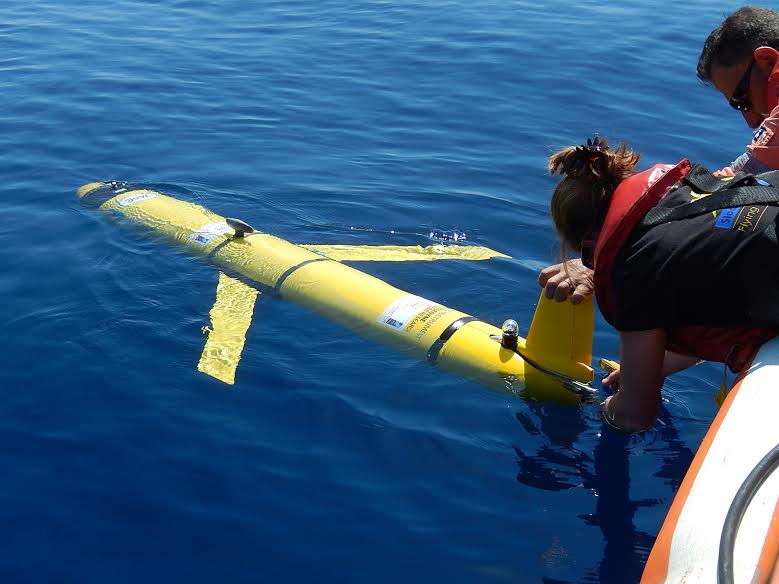
NATO Glider Experiment Underway in Sardinian Sea
12 June 2014 - From 6 to 26 June 2014 the Sardinian Sea will be the site of the REP14-MED experiment, lead by the NATO Centre for Maritime Research and Experimentation (CMRE), part of the NATO Science and Technology Organization. The exercise will take place onboard the NATO Research Vessel Alliance, operated by CMRE, and onboard Research Vessel Planet, operated by the German Research Centre WTD71, as well as remotely at research centres ashore. Scientists and engineers from 21 partners and six nations will test and develop new systems, technologies and solutions for ocean monitoring and seabed characterization.
The main pillar of experimentation is the use of underwater gliders from four Nations (UK, Germany, France, USA) and from NATO CMRE. Gliders are Autonomous Underwater Vehicles (AUVs) that use changes in buoyancy to dive and surface, and have wings to generate horizontal motion as part of this process. This unconventional method of propulsion (without the use of a propeller) is very energy-efficient and provides gliders with a long endurance that is well suited to monitoring the ocean.
In REP14-MED, a large number of gliders from different Institutions and manufacturers are simultaneously at sea to collect ocean physical data in order to to improve the performance of ocean forecast models; diagnose and predict physical properties of the waters west of Sardinia; develop and test efficient sampling strategies; develop and test new methods to characterize the seabed; record underwater ambient noise; and test recent developments in underwater observation techniques. CMRE gliders will be operated from the CMRE Command and Control Room in La Spezia, including new hybrid gliders capable of being switched between the standard gliding mode of propulsion and a faster (but less energy-efficient) mode that uses a propeller.
The partners’ consortium also comprises, among others, the Area Marina Protetta Penisola del Sinis (AMP) and the Istituto per l’Ambiente Marino Costiero del CNR (IAMC-CNR), both active in the local area.
Through REP14-MED, NATO will enable collaborative research to increase automation and effectiveness of coordinated geographical, meteorological, and oceanographic support for NATO operations.
NATO to Test Underwater Glider Swarms
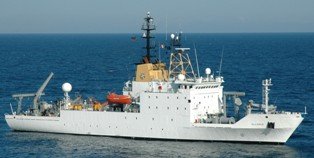
NATO's research vessel Alliance - NATO Image
4 June 2014 – NATO’s Science and Technology Organization – Centre for Maritime Research and Experimentation (CMRE) will host a media day 12 June for its upcoming Recognized Environmental Picture (REP) Mediterranean (MED) 2014 or REP14-MED, experiments.
REP14-MED is a joint sea trial of the NATO Research Vessel Alliance, operated by the NATO CMRE, and of the research vessel Planet, operated by the German Research Centre WTD71. REP14-MED is a large glider fleet experiment to be conducted in the Sardinian Sea. It includes gliders from four Nations (UK, Germany, France, USA) and from NATO. Gliders are Autonomous Underwater Vehicles (AUVs) that use changes in buoyancy to dive and surface, and have wings to generate horizontal motion as part of this process. This unconventional method of propulsion (without the use of a propeller) is very energy efficient and provides gliders with a long endurance well suited to monitoring the ocean. The partners’ consortium also includes the Area Marina Protetta Penisola del Sinis (AMP) and the Istituto per l’Ambiente Marino Costiero del CNR (IAMCCNR), both active in the local area. Through REP14-MED, NATO will enable collaborative research to increase automation and effectiveness of coordinated geographical, meteorological, and oceanographic support for NATO operations.
Personnel interested in attending this media event should contact CMRE’s Public Affairs Office at +39 335 7809721 or at pao@cmre.nato.int.
For more on underwater gliders, see LBS Glider, SeaExplorer, Seaglider, and Z-Ray.
NATO to Host Student AUV Competition
14 May 2014 - From 20 September to 3 October 2014 the NATO Centre for Maritime Research and Experimentation will host the Student Autonomous Underwater Vehicle Challenge - Europe (SAUC-E) for the fifth year in a row, and for the first time the euRathlon sea robotic competition.
The NATO Centre for Maritime Research and Experimentation (part of the NATO Science and Technology Organization) confirms and increases its commitment to foster a new generation of robotic engineers. In September 2014, in addition to the Student Autonomous Underwater Vehicle Challenge - Europe (SAUC-E) hosted for the fifth year in a row in CMRE’s sheltered harbour, the first euRathlon sea robotic competition will be held the following week. Each year SAUC-E challenges multidisciplinary University teams (consisting at least of 75% students members) to design and build Autonomous Underwater Vehicles (AUVs) capable of performing realistic missions. The students’ AUVs must perform a series of tasks autonomously facing real life conditions such as limited visibility in the sea, with no control, guidance or communication from a person or from any off-board computer including GPS systems. This 9th edition will be held from 20 to 26 September 2014.
The following week, from 29 September to 3 October 2014, for the first time CMRE will also host the euRathlon sea robotic challenge. The challenge is the second event of the euRathlon project, a three-year effort, funded by the European Commission, where robots and their teams of designers go head-to-head in a series of demanding outdoor scenarios that mimic the real challenges of a disaster situation. In 2015 the final Grand Challenge will feature all three elements (land, sea and air) to respond to a mock disaster scenario inspired by the Fukushima accident.
Competition scenarios for euRathlon 2014 have been designed to lead up to the Grand Challenge and will consist of five different marine scenarios: “Long range autonomous underwater navigation”, “Environmental survey of the accident area”, “Leak localisation and structure inspection”, “Interaction with underwater structures” and a “Combined scenario”. Teams and their robot vehicles may compete in one or more scenarios. All scenario tasks can be undertaken by a single AUV. However, in some scenarios a team can compete using only an Unmanned Surface Vehicle (USV), or a combination of USV and AUV.
Both SAUC-E and euRathlon competitions encourage participants to think about sea robotics and related applications while fostering innovation and technology. “Robot competitions are the most effective driver to boost new talents and support scientists to advance the state-of-the-art of marine vehicles” says RADM Hank Ort, CMRE Director. “We are proud to reconfirm our commitment to growing new talent in this area”
Cooperative fleet of underwater vehicles
being successfully tested by CMRE and eight research partners
6 August 2013 - From 22 to 27 July 2013, the NATO Centre for Maritime Research and Experimentation (CMRE) participated in the 2013 sea trials of the MORPH (Marine Robotic System of Self-Organising, logically Linked Physical Nodes) European Commission project, which aims to test the latest developments in multiple-vehicle coordination and formation flying based on echo-location. The trial occurred off the coast of Toulon (France) at the European Centre of Underwater Technologies, part of the French Institute for Exploitation of the Sea (Ifremer).
CMRE demonstrated the software for combined data communication and ranging technique for underwater acoustic networks. The technique takes advantage of the inherent broadcast nature of the acoustic channel and the precise local time tagging available at the modem hardware to infer time of flight of the acoustic packets. This permits to underwater robots to work together, navigate in formation and share data without any physical connection, by communicating through acoustic modems in an underwater wireless network. The result is a well-organized flock of drones, an underwater system composed of multiple, heterogeneous marine robots which cooperate to perform a mission.
CMRE’s contribution to the 2013 sea trials was instrumental in the success of the test as the coordination algorithms developed by the project partners rely on the ability to exchange data and estimate relative positions of the vehicles. With this core capability the Consortium (32 scientists from five countries and other eight research organizations) successfully demonstrated coordinated manoeuvers between four autonomous vehicles (two underwater and two surface) in a diamond-shaped formation.
This new robotic concept will provide efficient methods to map the undersea environment with great accuracy in challenging environments, with rugged terrain or structures with full 3D complexity. Field applications of this Project includes harbor protection, environmental and industrial infrastructures monitoring (as for example for offshore installations or pipelines), and mine countermeasures.
The MORPH project is a 4-year-long effort, launched in February 2012, and funded by the European Commission with an overall budget of 8.5 million euro within the EU 7th Framework Program.
comments powered by Disqus